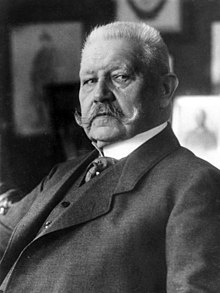
Back Paul von Hindenburg ALS باول فون هيندنبورغ Arabic پول فون هيندنبورج ARZ Paul von Hindenburg AST Paul fon Hindenburq AZ Паўль фон Гіндэнбург BE Паўль фон Гіндэнбург BE-X-OLD Паул фон Хинденбург Bulgarian Paul von Hindenburg BR Paul von Hindenburg BS
Paul von Hindenburg | |
|---|---|
 Hindenburg in the 1920s | |
| 2nd President of Germany | |
| In office 12 May 1925 – 2 August 1934 | |
| Preceded by | Friedrich Ebert (acting President Walter Simons) |
| Succeeded by | Adolf Hitler (Führer and Chancellor) |
| Chief of the German General Staff | |
| In office 1916–1919 | |
| Preceded by | Erich von Falkenhayn |
| Succeeded by | Wilhelm Groener |
| Personal details | |
| Born | October 2, 1847 Posen (Poznań), German Confederation |
| Died | August 2, 1934 (aged 86) Neudeck, East Prussia, Nazi Germany |
| Nationality | German |
| Political party | None |
Paul Ludwig Hans Anton von Beneckendorff und von Hindenburg (2 October 1847 – 2 August 1934) was a German field marshal and statesman.
Hindenburg retired from the army in 1911. He rejoined the German army at the start of the First World War. He became famous when he won the Battle of Tannenberg in 1914.
Hindenburg retired again in 1919, but returned to public life one more time in 1925 to be elected as the second President of Germany.
He was 84 years old and in poor health, but decided to run for re-election in 1932 as the only candidate who could defeat Adolf Hitler, because he saw him as a dangerous extremist. He tried to stop Hitler's and the Nazi Party's rise to power, but Franz von Papen persuaded Hindenburg, that the Conservative elite and the military could control Hitler when he becomes Chancellor of Germany and that the other more dangerous alternative was Communist rule.
As a result, Hindenburg appointed Hitler as Chancellor on 30 January 1933. But von Papen's belief in controlling Hitler and his assurances to Hindenburg did not happen, because Hitler started to control them and gain more power. In March he signed the Enabling Act of 1933 which gave special powers to Hitler and his government.
With this act, Hitler became a dictator in the next months, and crushed all opposition and banned all political parties, except the Nazi Party by the summer of 1933. Hindenburg died the next year, after which Hitler declared the office of President vacant and made himself Führer (Head of State and Head of Government) of Germany.
The famous zeppelin Hindenburg that was destroyed by fire in 1937 had been named in his honour, as is the causeway joining the island of Sylt to mainland Schleswig-Holstein, the Hindenburgdamm, built during his time in office.